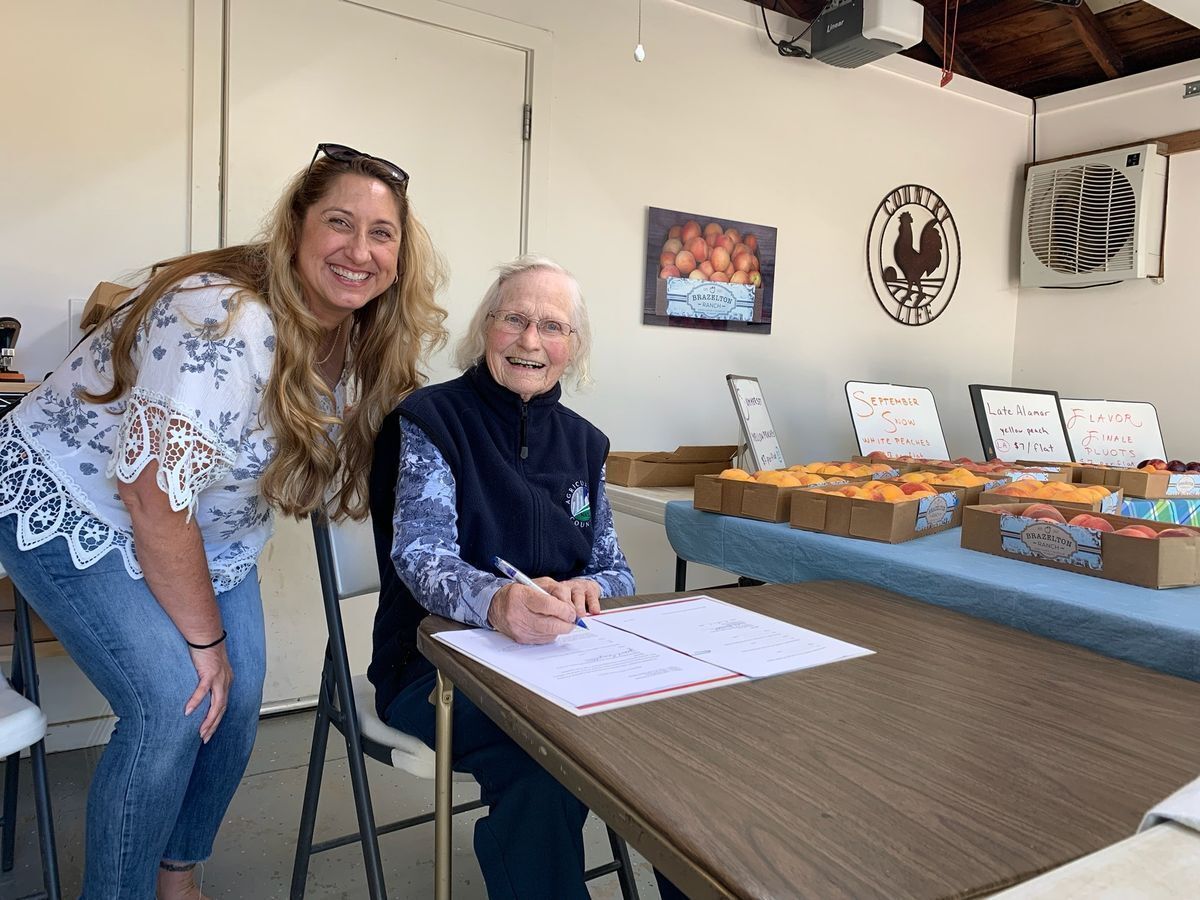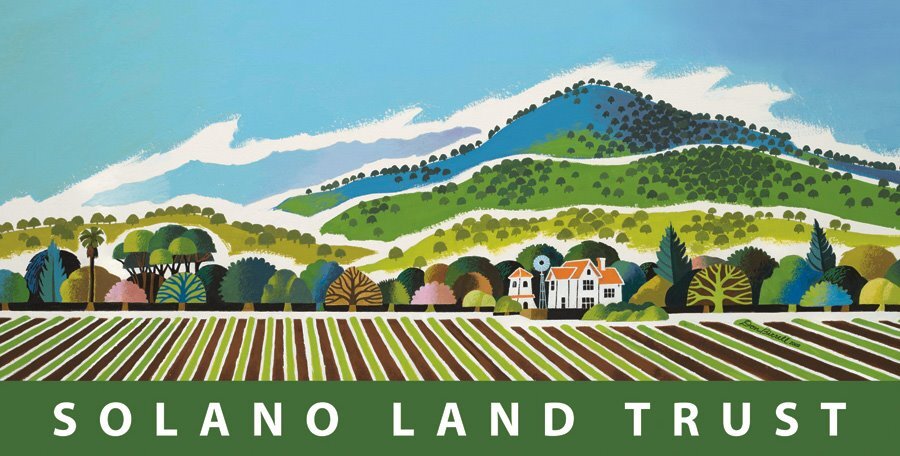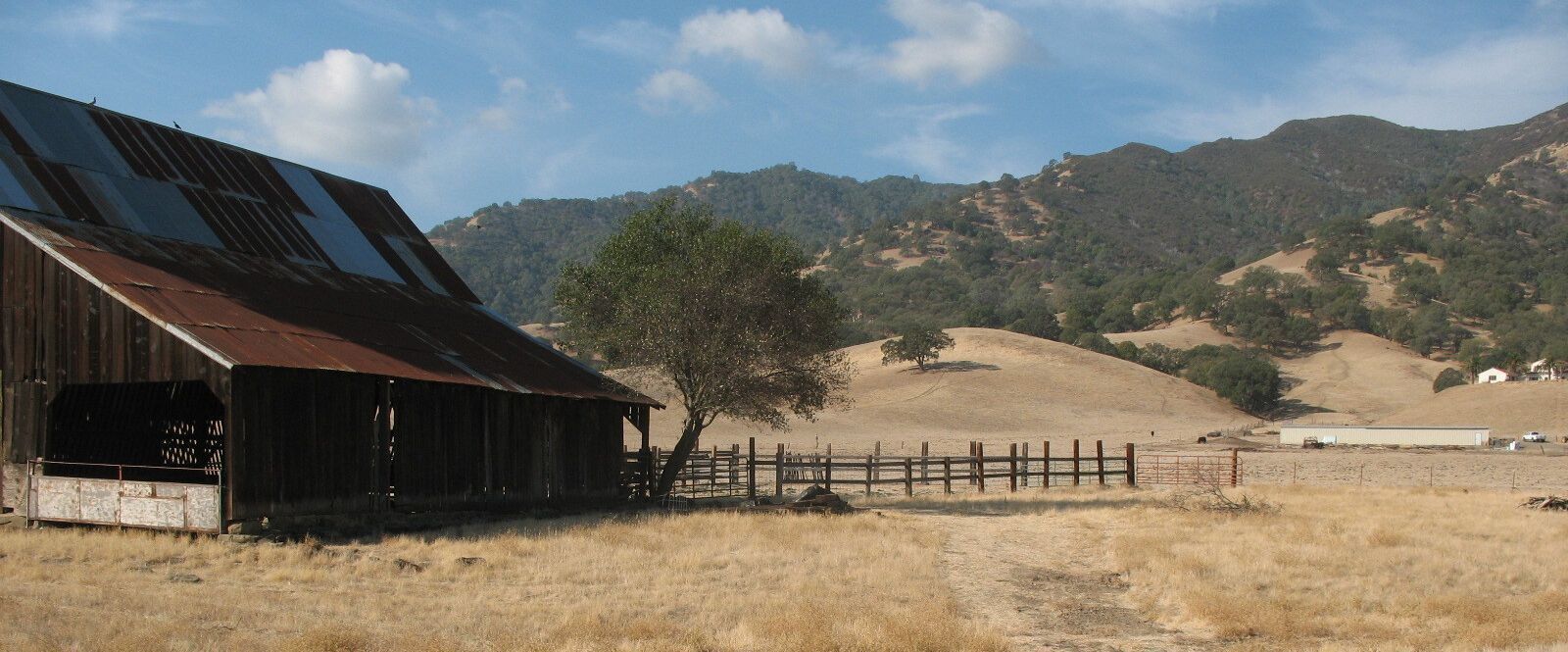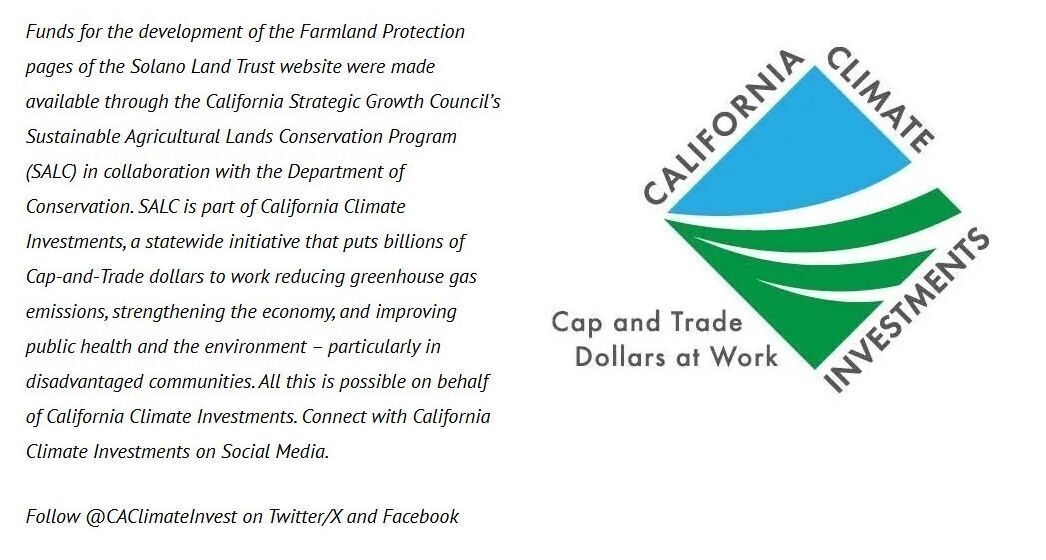Agricultural conservation agreements are a valuable tool for landowners who want to permanently protect their land from conversion to other uses. Solano Land Trust develops conservation agreements in partnership with willing owners of farmland and ranchland in Solano County. These agreements benefit participating landowners, our local agricultural community and Solano County residents. We all benefit from clean air and water, healthy local food and the scenic open spaces while traveling throughout our country.
Conservation Agreement Facts and Questions
- What do landowners gain when they protect their property with a conservation agreement?
- What rights do landowners give up when they protect their property with conservation agreement?
- How is the value of an agricultural conservation agreement determined?
- Who owns a property once a conservation agreement is in place?
- Why do you monitor the conservation agreement?
- Must my property be open to hikers and/or others?
- How can a landowner use the funds they receive when they enter into an agricultural conservation agreement with Solano Land Trust?
- Where does the money come from to pay for agricultural conservation agreements?
- What kind of lands does Solano Land Trust protect using agricultural conservation agreements?
- How does Solano Land Trust partner with public agencies and landowners to meet regional priorities, like protecting agricultural lands and other areas with important natural resources to offset development impacts?
- How can a Solano County landowner partner with Solano Land Trust to protect their land?
-
What do landowners gain when they protect their property with a conservation agreement?
Farmers and ranchers who protect their land with agricultural conservation agreements have the peace of mind that comes with knowing their property will always be protected as working land. The opportunity to sell a conservation agreement can make it possible to maintain ownership of the family farm. Landowners that sell agricultural conservation agreements are paid the difference between the unrestricted market value of their land and the value of the land once it is restricted. Properties with agreements often pay lower property taxes due to the extinguishment of some development. If a landowner donates all or part of the agreement, they may be eligible for significant tax benefits.
-
What rights do landowners give up when they protect their property with conservation agreement?
Depending on the negotiated and agreed-upon terms between the seller (landowner) and buyer (in this case, Solano Land Trust) of an agricultural conservation agreement, the landowner agrees to permanently give up some or all development rights on the encumbered property. Future owners of that land will also be prevented from subdividing or developing property covered by a conservation agreement. Every conservation agreement is unique, with specific terms negotiated to meet the needs of both the seller and the buyer.
-
How is the value of an agricultural conservation agreement determined?
The value of the development rights that are sold when a conservation agreement is put in place is determined by independent third-party appraisers who are experienced in determining the fair market value of restricted agricultural land as compared to what the land would be worth with full development rights. The dollar value of these agreements is set by these appraisals and is not negotiable once the terms of a conservation agreement are set.
-
Who owns a property once a conservation agreement is in place?
When a landowner enters into an agreement for an agricultural conservation agreement, they retain ownership and title to the land. Solano Land Trust does not get involved in the day-to-day operations on the land, provided landowners continue to comply with the negotiated terms of the conservation agreement. However, conservation agreements with SLT do require landowners to allow Solano Land Trust employees to conduct annual site visits to ensure the terms of the agreement are honored.
-
Why do you monitor the conservation agreement?
By accepting the grant of the conservation easement, Solano Land Trust is obligated to enforce the terms of the original agreement. Occasionally, not often, a landowner (usually not the owner who originally established the conservation easement) may intentionally or unintentionally violate the terms of the conservation easement. We annually monitor each property in our conservation portfolio to answer questions from the landowner about the easement restrictions, and to confirm that no violations have occurred. Our annual monitoring is designed to educate each owner about the importance of the terms of the conservation easement. We are tasked with and required by law, to enforce the terms of the agreement in order to meet the intent of the agreement, the wishes of the original landowner and the funder requirements. Legal action can take place to cure the violation. Land Trusts work hard to keep an open and friendly relationship and partnership with the landowner. Many conversations will be had before any legal action takes place.
-
Must my property be open to hikers and/or others?
No, public access is at the owner’s discretion. The only required access on conservation easement properties is an annual monitoring visit by a Solano Land Trust staff member or qualified volunteer.
-
How can a landowner use the funds they receive when they enter into an agricultural conservation agreement with Solano Land Trust?
The sale of an agricultural conservation agreement provides a cash infusion that can support ongoing operations, pay for investments in the agricultural operation, help to cover estate taxes, or be spent in any way the property owner wishes.
-
Where does the money come from to pay for agricultural conservation agreements?
Solano Land Trust uses funding from a wide variety of state and federal agencies like the State of California, Department of Conservation, and the USDA Natural Resources Conservation Service (NRCS) to purchase conservation agreements. Funding also comes from foundation grants, mitigation funding from cities and developers, and donations from people like you! These funds cover the purchase price of agricultural conservation agreements and cover transaction costs related to purchasing agreements.
-
What kind of lands does Solano Land Trust protect using agricultural conservation agreements?
Solano Land Trust purchases agricultural conservation agreements on properties that have active agricultural operations in Solano County, with a priority focus on high quality agricultural lands. Though each property is unique and may fit a certain need or funding opportunity, all landowners are encouraged to connect with the land trust and learn what opportunities may be available.
-
How does Solano Land Trust partner with public agencies and landowners to meet regional priorities, like protecting agricultural lands and other areas with important natural resources to offset development impacts?
When cities within Solano County approve development of housing and other critical community needs, these developments are often built on land on the edges of a city. In these cases, local, state and federal laws may require mitigation in the form of protecting “like for like” land or other local agricultural properties and/or lands that provide habitat for native species, groundwater recharge, and other key benefits that might be lost through developing land. Solano Land Trust may collaborate with cities or developers to manage a mitigation requirement by purchasing a conservation agreement on working lands that meet the project’s specific mitigation requirements.
-
How can a Solano County landowner partner with Solano Land Trust to protect their land?
For information about selling or donating an agricultural conservation agreement to Solano Land Trust, contact Conservation Director Tracy Ellison at tracy@solanolandtrust.org or info@solanolandtrust.org . Every agreement is different. We’re looking forward to starting the conversation.



